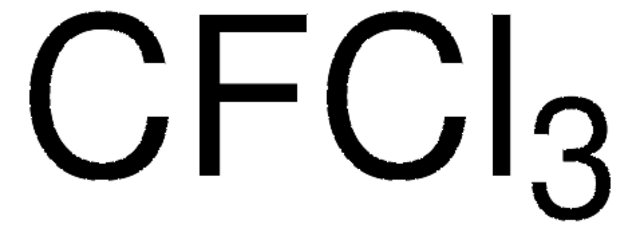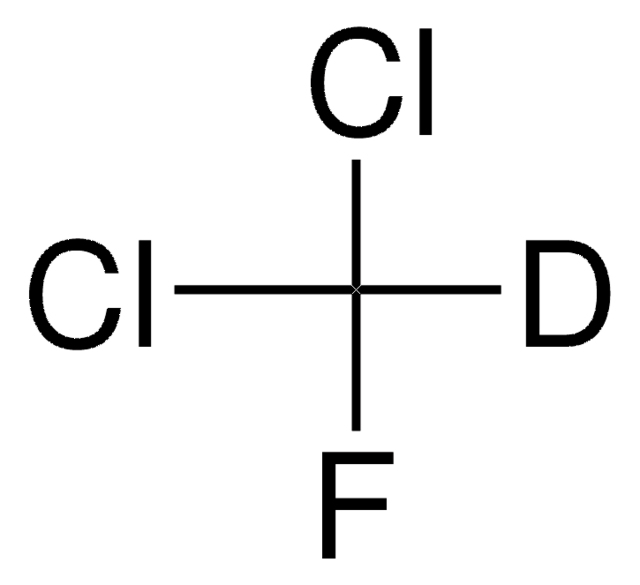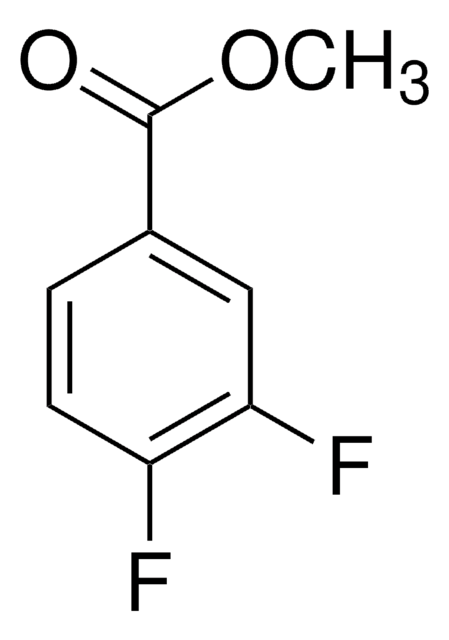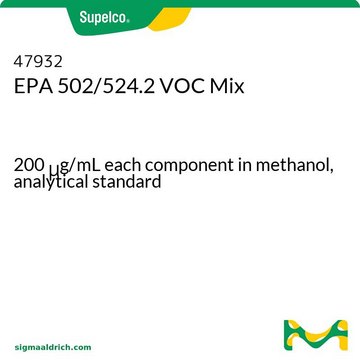48623
Dichlorodifluoromethane solution
200 μg/mL in methanol, analytical standard
Sign Into View Organizational & Contract Pricing
All Photos(1)
About This Item
Recommended Products
grade
analytical standard
Quality Level
packaging
ampule of 1 mL
concentration
200 μg/mL in methanol
technique(s)
HPLC: suitable
gas chromatography (GC): suitable
application(s)
environmental
format
single component solution
storage temp.
2-8°C
InChI
1S/CCl2F2/c2-1(3,4)5
InChI key
PXBRQCKWGAHEHS-UHFFFAOYSA-N
Looking for similar products? Visit Product Comparison Guide
Application
Refer to the product′s Certificate of Analysis for more information on a suitable instrument technique. Contact Technical Service for further support.
Signal Word
Danger
Hazard Statements
Precautionary Statements
Hazard Classifications
Acute Tox. 3 Dermal - Acute Tox. 3 Inhalation - Acute Tox. 3 Oral - Flam. Liq. 2 - STOT SE 1
Target Organs
Eyes
Storage Class Code
3 - Flammable liquids
WGK
WGK 1
Flash Point(F)
51.8 °F - closed cup
Flash Point(C)
11 °C - closed cup
Regulatory Information
监管及禁止进口产品
Choose from one of the most recent versions:
Already Own This Product?
Find documentation for the products that you have recently purchased in the Document Library.
Total toxicity equivalents emissions of SF6, CHF3, and CCl2F2 decomposed in a RF plasma environment.
Ya-Fen Wang et al.
Chemosphere, 62(10), 1681-1688 (2005-08-09)
Sulfur hexafluorine compound (SF6), trifluoromethane (CHF3) and diclorodifluoromethane (CCl2F2) are extensively used in the semiconductor industry. They are global warming gases. Most studies have addressed the effective decomposition of fluorine compounds, rather than the toxicity of decomposed by-products. Hence, the
Yukinori Maruo et al.
Dental materials journal, 24(3), 311-314 (2005-11-11)
The purpose of this study was to examine if a modified direct relining method could result in excellent denture adaptation compared to a conventional method. Direct relining was done using heat-polymerized acrylic resin base on a maxillary cast with two
S-K Wang et al.
Journal of physics. Condensed matter : an Institute of Physics journal, 23(43), 435011-435011 (2011-10-15)
Continuous-time core-level photon-stimulated desorption (PSD) spectroscopy was used to investigate the monochromatic soft x-ray photoreactions of CF(2)Cl(2) adsorbed on Si(111)-7 × 7 near the F(1s) edge (681-704 eV). Sequential F(+) PSD spectra were observed as a function of photon exposure
Tsukasa Tamai et al.
Environmental science & technology, 40(3), 823-829 (2006-03-03)
The decomposition of CCl2F2 to CO2 and accompanying halogen fixation by a CaO based material was studied. To improve the low reactivity of CaO, a consequence of its low surface acidity, transition metal oxides were added. Impregnation of metal acetylacetonate
D Chen et al.
Guang pu xue yu guang pu fen xi = Guang pu, 18(3), 319-324 (2005-04-07)
For the management of refractory hazardous wastes, an innovative technology emerging recently is the application of ultra high temperature plasma. The preliminary study on destruction of Freon 12 by ICP (1-2kW) under a joint program between Xiamen Univ. and Hong
Our team of scientists has experience in all areas of research including Life Science, Material Science, Chemical Synthesis, Chromatography, Analytical and many others.
Contact Technical Service










